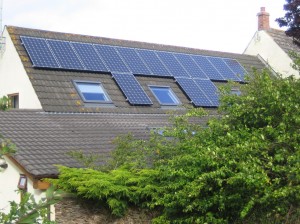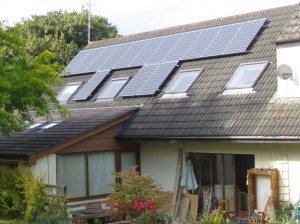For a long time I’ve been tempted by a solar photovoltaic (PV) installation, but been unable to convince myself that it would be financially worthwhile. A couple of months ago however a friend was telling me about his new installation and I decided to look at the figures again. Our house has a large area of roof that faces south-west and originally being thatched is of steeper pitch than many modern houses, giving the potential for better performance during the winter, so I was quite hopeful.
The current domestic Feed-In Tariff (FIT) payment levels are 43.3p per kWh generated, regardless of whether the power is used on-site or exported, and a further 3.1p/kWh for power exported, though at the moment unless you have an export meter 50% of your production is assumed to be exported, giving an average figure of 44.85p/kWh generated. The payment levels are linked to the RPI and free of income tax for domestic installations generating electricity mainly for use on-site.
I had a rough idea of what a 4kWp installation should cost to install, so set up a spreadsheet to work out payback times based on different changes in the RPI and in the cost of electricity based on sunlight levels at my location (I’m told the government-mandated models use the sunlight levels in Sheffield). The figures actually worked out quite well, paying back the installation cost in around six to seven years and earning in the region of £75,000 over the twenty-five year period, so I decided to get some quotes from local suppliers.
The company that impressed me the most of all of the suppliers who quoted was Somerset Solar Electric, who emailed a number of drawings for different arrangements of panels as well as suggestions for three different sets of panels with a list of pros and cons for each. In the end we went for a system of fourteen Sungrid SG-260 panels which gave us an output close to the maximum Western Power would allow us to feed into the grid on a single phase.
The installation itself took three days from start to commissioning despite being done a little out of the order I was expecting because they were delayed on a previous installation due to bad weather. The electrician arrived first and ran the cabling to connect the inverter in the loft to our incoming supply in the cellar. As luck would have it I had lots of the floor lifted to do some plumbing work, so we took the opportunity to run the cable neatly inside the house rather than on an outside wall. I got the impression the panels were a relatively easy installation, partly because the roof comes down to the first floor ceiling level and partly because it is tiled rather than slated, allowing tiles to be slipped aside to fix the mounting brackets to the rafters. To install the mounting rails and get all the panels in place took just over a day and a half and the system was fully commissioned the same afternoon, on 1st September.
The weather since has been really quite poor in terms of hours of sunshine, but despite that we’re still producing 10kWh per day on average. The inverter we’re using, a Power One Aurora, as an RS232 connector through which I can get actual production figures on an ongoing basis, so once I have that figured out I’ll set some “real-time” graphs up. And get my weather station running again so it’s possible to relate power production to the weather. Given that we’re not far off the Autumn solstice it seems reasonable to use that 10kWh figure as an average daily production figure for the year, in which case my original spreadsheet models have under-estimated production slightly, so I’m happy about that.
For the record, the installation is 3.64kWp, on a roof of approximately 45 degrees pitch, facing south-west.
I’ve now filled in my application forms to sign up for FITs and sent them off to Good Energy. Roll on my first payment…
Finally, a couple of pictures of the installed panels:


